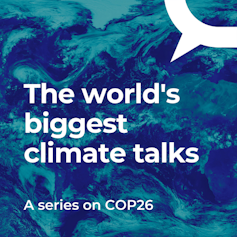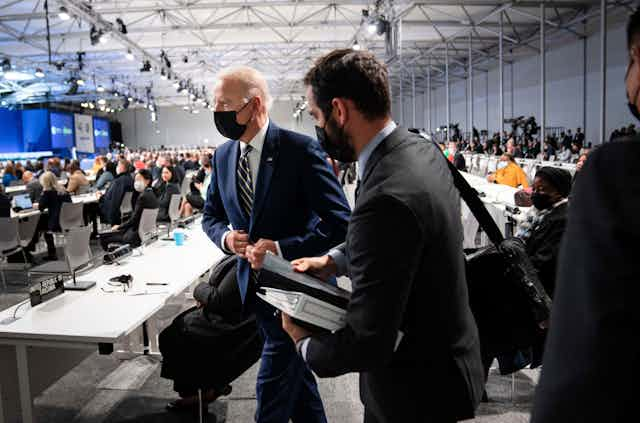Glasgow sits proudly on the banks of the river Clyde, once the heart of Scotland’s industrial glory and now a launchpad for its green energy transition. It’s a fitting host for the United Nations’ climate conference, COP26, where world leaders are discussing how their countries will reduce the greenhouse gas emissions that are driving climate change.
I’ve been involved in climate negotiations for several years as a former senior U.N. official and am in Glasgow for the two-week conference that started Oct. 31, 2021. With heads of state heading home after two days of high-level speeches and announcements, negotiations are underway. Here’s what to watch for.
Ambition
At the Paris climate conference in 2015, countries agreed to work to keep global warming well below 2 degrees Celsius (3.6 Fahrenheit), aiming for 1.5 C (2.7 F). If COP21 in Paris was the agreement on a destination, COP26 is the review of itineraries and course adjustments.
The bad news is that countries aren’t on track. They were required this year to submit new action plans – known as national determined contributions, or NDCs. The U.N.’s latest tally of all the revised plans submitted in advance of the Glasgow summit puts the world on a trajectory to warm 2.7 C (4.86 F), well into dangerous levels of climate change, by the end of this century.

All eyes are on the G-20, a group of leading world economies that together account for almost 80% of global emissions. Their annual summit in Rome on Oct. 30-31, they stopped short of committing to reach net zero emissions by 2050.
Brazil, Mexico, Australia and Russia have filed plans that are not in line with the Paris Agreement. India’s Prime Minister Narendra Modi announced a net zero target of 2070, but significantly committing to 50% energy from renewable sources by 2030. He asked for the international community to help finance that rapid increase and ticked the box on ambition.
China’s updated plan changed little from what it announced a year ago. It currently involves cutting emissions 65% per unit of gross domestic product, a measure known as carbon intensity, by 2030 compared to 2005 levels; moving up the date when the country’s emissions growth will peak to “before 2030” from “around 2030”; and setting industrial production targets for other greenhouse gases, such as methane. That peaking date needs to be 2026 – no later.
Meanwhile the world’s eyes are on the United States. Opposition from two Democratic senators, Joe Manchin of West Virginia and Kyrsten Sinema of Arizona, forced the Biden administration to scrap a plan that would have incentivized utilities to switch to cleaner power sources faster. President Joe Biden’s Plan B, announced less than a week before the summit, may not be enough to reach the United States’ 2030 emissions targets.
The U.S. has been a big impetus behind new announcements on curbing methane emissions 30% by 2030 and ending deforestation by 2030, but has a way to go in contributions on climate finance.
Carbon markets
One leftover task from the Paris conference is to set rules for carbon markets, particularly how countries can trade carbon credits with each other, or between a country and a private company.
Regulated carbon markets exist from the European Union to China, and voluntary markets are spurring both optimism and concern. Rules are needed to ensure that carbon markets actually drive down emissions and provide revenue for developing countries to protect their resources. Get it right and carbon markets can speed the transition to net zero. Done badly, greenwashing will undermine confidence in pledges made by governments and companies alike.
Another task is determining how countries measure and report their emissions reductions and how transparent they are with one another. This too is fundamental to beating back greenwashing.
Also, expect to see pressure for countries to come back in a year or two with better plans for reducing emissions and reports of concrete progress.
Climate finance
Underpinning progress on all issues is the question of finance.
Developing countries need help to grow green and adapt to climate change, and they are frustrated that that help has been on a slow drip feed. In 2009 and again in 2015, wealthy countries agreed to provide $100 billion a year in climate finance for developing nations by 2020, but they haven’t reached that goal yet.
Just ahead of the summit, the U.K. revealed a climate finance plan, brokered by Germany and Canada, that would establish a process for counting and agreeing on what counts in the $100 billion, but it will take until 2023 to reach that figure.
On the one hand it is progress, but it will feel begrudging to developing countries whose costs of adaptation now must be met as the global costs of climate impacts rise, including from heat waves, wildfires, floods and intensifying hurricanes, cyclones and typhoons. Just as with the global vaccine rollout, the developing world may wonder whether they are being slow-walked into a new economic divergence, where the rich will get richer and the poor poorer.
Beyond the costs of mitigation and adaptation is the question of loss and damage – the innocuous term for the harm experienced by countries that did little to contribute to climate change in the past and the responsibility of countries that brought on the climate emergency with their historic emissions. These difficult negotiations will move closer to center stage as the losses increase.
Public climate finance provided by countries can also play another role through its potential to leverage the trillions of dollars needed to invest in transitions to clean energy and greener growth. Expect big pledges from private sources of finance – pension funds, insurance companies, banks and philanthropies – with their own net zero plans, including ending finance and investments in fossil fuel projects, and financing critical efforts to speed progress.
It’s raining pledges
A cross section of the world will be in Glasgow for the conference, and they will be talking about pathways for reducing global carbon emissions to net zero and building greater resilience.
From emissions-free shipping to aviation, from ending public financing for coal and other fossil fuel projects outside their borders to expanding the use of green steel and cement, from platforms to reduce methane, to nature-based solutions, the two-week conference and days leading up to it will see a steady stream of commitments and new groups of countries, nongovernmental organizations and businesses working together.
Keeping track and verifying achievements toward these pledges will be critical coming away from COP26. U.N. Secretary-General António Guterres announced that he will convene experts to help ensure that net-zero pledges are real, and he warned of the dangers of greenwashing. Without that discipline, climate activist Greta Thunberg’s “blah blah blah” speech thrown at delegates to a pre-COP meeting in Milan a few weeks ago will continue to echo around the world.

This story is part of The Conversation’s coverage of COP26, the Glasgow climate conference, by experts from around the world.
Amid a rising tide of climate news and stories, The Conversation is here to clear the air and make sure you get information you can trust. Read more of our U.S. and global coverage.
This article was updated Nov. 3 with the new announcements on methane, deforestation and new plans from the U.S. and India.

